One of them is boring, the other fearless. One of them is aimless,
the other determined. One of them is predictable, the other
exciting. The lesson is that, one day, the 46 years will be
consumed all the same. At the end, results will be trivial or
spectacular, meaningless or irreplaceable.
911
If you don't like the outcome of your calculations, take a blank
piece of paper, draw a new vertical line, and start the exercise
again. After a few times, you will get quite good at it. At one
point, you will begin to fear boring activities more than risky
ones. If you are already there, congratulations, now you know
how to win the game.
The Art of Obstacle Removal
One of the best ways to go faster is to remove the things that
slow you down. This "obstacle removal" is an integral part of
many agile methods including Scrum and Lean. Sometimes it is
obvious where an obstacle is. There are a few small things that
can be done easily to go faster. But to get going really fast, we
need to have a deeper understanding of obstacles... and the Art of
Obstacle Removal.
What are Obstacles?
An obstacle is any behavior, physical arrangement, procedure or
checkpoint that makes getting work done slower without adding
any actual contribution to the work. Activities that do add value
to our work may be slowed down by obstacles, but are not
obstacles in and of themselves.
Obstacles and Waste
Obstacles are the causes of waste in a process. There are many
types of waste, and for every type of waste there are many
possible sources (obstacles).
Types of Obstacles
Personal
Personal obstacles are related to us as individuals. There are
several levels at which these obstacles can show up.
Outside factors in our lives such as illness or family obligations
can become obstacles to our work at hand. These obstacles are
912
hard to remove or avoid. Even if we would want to avoid an
obstacle such as illness, it is hard to do anything about it in an
immediate sense. However, as part of our commitment to the
group we are working with, we should consider doing things to
generally improve our health. Good sleep, healthy and moderate
eating, exercise and avoidance of illness-causing things and
circumstances are all possible commitments we can make to the
group. Likewise, we can make sure our personal affairs are in
order so that unexpected events have the least impact possible.
This topic is vast and there are many good sources of
information.
Physical Environment
Obstacles in the physical environment can consist of barriers to
movement or communication, or a lack of adequate physical
resources. Sometimes these obstacles are easy to see because
their effects are immediate. For example, if a team room lacks a
whiteboard for diagrams, keeping notes, etc., then the team may
not be able to communicate as effectively.
Other physical obstacles are not so obvious. The effects of
physical environment can be subtle and not well-understood.
Poor ergonomics take weeks, months or years for their effects to
be felt... but it is inevitable. A too-small team room can lead to a
feeling of being cooped up and desperation to get out... and
eventually to resentment. Again this can take weeks or months.
Knowledge
A lack of knowledge or the inability to access information are
obstacles. A team composed of junior people who don't have
diverse experience and who don't have a good knowledge of the
work they are doing will have trouble working effectively. There
may be barriers preventing the team from learning. Common
barriers include over-work leading to a lack of time or mental
energy for learning. With junior people in particular, there is a
913

lot of pressure to be productive and that can often be at the
expense of a solid foundation of learning.
Other times, knowledge-related barriers can be more immediate.
If a critical piece of information is delayed or lost this can have a
large impact on an Agile team that is working in short cycles. The
team may be temporarily halted while they wait for information.
Building effective information flow is critical to a team's
performance.
Organizational
Bureaucratic
procedures,
organizational
mis-alignment,
conflicting goals, and inefficient organizational structures can all
be significant obstacles.
One of the best sources of information about this is the two
books by Jim Collins: "Good to Great" (Review) and "Built to
Last"
Cultural
Sometimes the beliefs we have about how to work can become
obstacles to working more effectively. These beliefs are often in
place because they have been part of what we think makes us
successful. Cultural assumptions can come from our families, our
communities, our religious affiliation and our national identity.
In organizational culture, one thing I constantly see is a public
espoused value of teamwork, but a conflicting behavior of
individual performance reviews and ranking. This is cultural. It is
also a barrier to the effective functioning of an Agile team. For
corporate environments I highly recommend the Corporate
Culture Survival Guide by Edgar Schein.
914
Dis-Unity
Dis-unity is one of the most subtle and common forms of
obstacle. Competition, legal and cultural assumption of the
goodness of "opposition" and habits of interaction including
gossip and backbiting all combine to make united action and
thought very difficult.
This is an extremely deep topic. There are many tools and
techniques available to assist with team building. If you are
interested in this topic, I highly recommend reading "The
Prosperity of Humankind".
Eliminate Waste
Waste is the result of activities or environmental conditions that
prevent a team from reaching its goal. The opposite of waste is
something that adds value (more, faster or higher quality) to the
desired result.
The whole notion of eliminating waste comes from lean
manufacturing. More recently, Mary and Tom Poppendieck
applied this idea to software in their book "Lean Software
Development: An Agile Toolkit for Software Development
Managers". In this (excellent) book, the authors list the wastes of
manufacturing and the wastes of software.
As wastes are eliminated or reduced, a team will function faster
and with higher quality. However, not all waste can be
eliminated. Sometimes waste is legislated, sometimes waste is an
unavoidable by-product of work, sometimes mistakes are made,
and sometimes it takes a great deal of effort to eliminate a waste.
915
Here I have summarized and generalized these types of wastes
so that they apply in any situation:
The Seven Wastes
1. waiting - caused by delays, unreadiness, or simple
procrastination
2. partially done work or inventory - caused by sub-optimal
workflow
3. extra processing or processes - caused by poor organization
or bureaucracy
4. defects and rework - caused by insufficient skill, tools,
inspection or filtering
5. movement of people or work - caused by physical separation
6. overproduction or extra features - caused by working
towards speculative goals
7. task switching - caused by multiple commitments
In order to eliminate waste, first waste has to be detected and
identified, then the underlying causes of the waste have to be
identified, and finally changes to the work environment need to
be made to both eliminate the cause of the waste and the waste
itself. Many agile work practices help with this process.
Value stream mapping is one particular tool that can be used by
a team or organization to identify wasteful activities. The team
describes the amount of time that work takes to go through each
activity in their overall work process. Next, the team determines
if each activity adds value or does not add value to the end goal.
All activities are subject to speed improvements, and activities
that do not add value are subject to elimination.
In order to determine the causes of waste, special attention
should be paid to incentives and motivations. Wasteful behavior
often exists because there is some incentive for people to do it.
916
Sometimes these incentives are explicit, but sometimes they are
the side-effects of other things going on in the team's
environment. Changing the incentives can be an effective way of
reducing waste.
By eliminating waste, the team will find it has reduced
frustrations, and enabled greater productivity and creativity. The
team will also increase its speed and delivery of value, and at the
same time reduce defects.
Removing Obstacles
The ability to identify obstacles and understand why they are
causing problems is only the first step in removing obstacles. In
Agile Work, the person primarily responsible for identifying and
removing obstacles is the Process Facilitator. The Process
Facilitator has several approaches available for the removal of
obstacles. A process facilitator has similar responsibilities to a
change agent.
Direct
Deal with the obstacle directly without involving other people.
This can be as simple as getting up and moving an obstacle
impairing vision, or as nuanced as running interviews and
workshops throughout an organization to gradually change a
cultural obstacle.
Command and Control
Identify the obstacle and give precise instructions for its removal
to a person who will directly perform the removal. This can
sometimes work if removing an obstacle takes a great deal of
time, effort or specialized skills that you yourself do not possess.
However, the overall approach of "command and control" is not
recommended for Agile environments since it is disempowering.
917

Influence
Identify the obstacle and suggest means to deal with it to a
person who has the authority or influence to get others to deal
with it. This indirect method of obstacle removal can be slow and
frustrating. However it usually has better long-term effects than
command and control.
Support
Offer to assist and encourage the removal of obstacles that have
been identified by other people. In many respects this is a very
effective method. It can assist with team-building and learning
by example. People are usually grateful for assistance.
Coaching
Train others on the art of obstacle removal including obstacle
identification, types of obstacles and strategies for dealing with
obstacles. Observe people's attempts to remove obstacles and
give them feedback on their actions.
Creating a Culture of Obstacle Removal
Encourage and measure obstacle removal at all organizational
levels until it becomes habitual. In many ways this is the essence
of the lean organization.
918
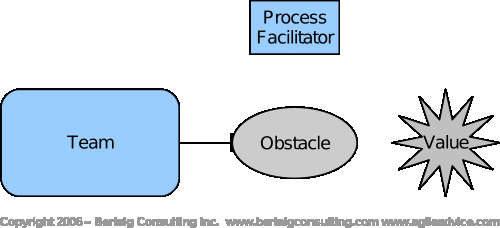
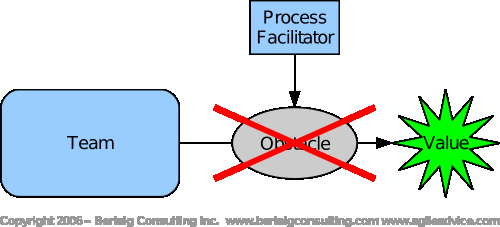
Strategies for Dealing with Obstacles
Diagrams are a great way of communicating the essense of a
concept. Feel free to share the following diagrams with anyone
(but of course keep the copyright notice on them).
Remove
Remove the obstacle altogether. This method of dealing with an
obstacle is usually the most immediately effective, but is also one
of the most difficult methods.
919
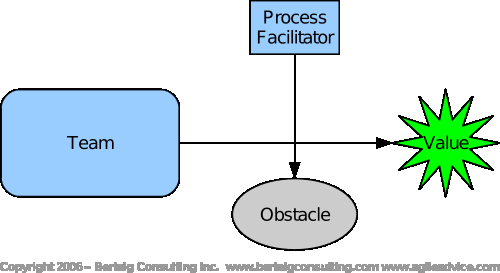
The best way to actually remove an obstacle is to get at the root
cause of the obstacle and change that. This type of change results
in the longest-lasting and most stable elimination of an obstacle.
Move Aside
Take the obstacle and put it in a place or situation where it is no
longer in the path of the team.
In a team's physical environment, this may be as simple as
changing the tools that the team is using. For example, if the
team is all in a room together, move computer monitors that are
blocking team member's views of each other. If there is a useless
checkpoint that work results have to go through, get
management to eliminate it.
Shield
Build a shield or barrier to hide the obstacle so that it's effects no
longer touch your team.
920
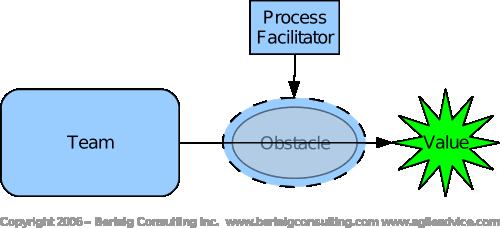
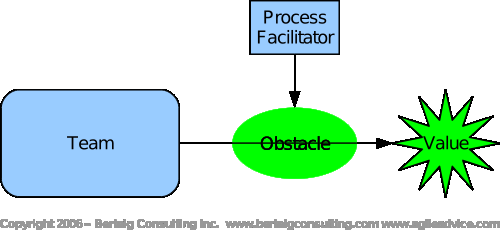
If a team is distracted by noisy neighbors, put up a sound barrier.
If a team is unable to see their computers due to late afternoon
sunlight, put up window shades. If a manager is bothering the
team with meetings or tasks unrelated to the work of the team,
then put yourself between the team and the manager (or get
someone in upper management to do that).
Shielding is excellent for immediate relief, but remember that
the obstacle is still there and may become a problem again if the
shield cannot be maintained.
Transform
Change the structure or form of the obstacle so that it no longer
affects effectiveness.
921
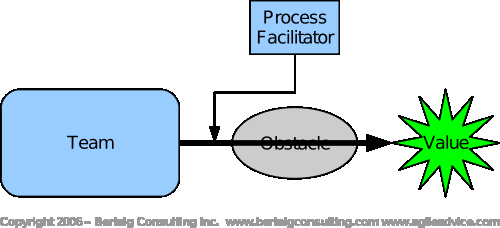
In general, this method requires a great deal of creativity and
open-mindedness. This is one that works particularly well on
people who are obstacles: convert them into friends of the team!
For example if the team needs approval of an expert who is not
part of the team, this can cause extra work preparing
documentation for this person and long delays while the expert
revies the documents. If the expert becomes part of the team,
then they are well-informed of the work being done and can give
approval with very little overhead.
If done well, this can be a very long-lasting method of dealing
with an obstacle. Make sure that the transformation is true and
that it takes hold... and beware that the obstacle doesn't revert
back to its old nature.
Counteract
Find an activity that negates the effects of the obstacle by
boosting effectiveness in another area.
As a coach or Process Facilitator, this is what we spend our time
in early in a team's adoption of Agile Work: we get them to work
in the same room, use iterations and adaptive planning, we focus
them on delivering work valued by the stakeholders as defined
922
by the Product Owner. All these things are enhancing the team's
ability to get work done without actually directly dealing with
any obstacles.
Watch out for barriers avoided this way to come back and bite
you later on.
Removing Obstacles and Learning
Organizational learning, as well as adult learning have a strong
relationship to obstacle removal. Organizational learning can be
either single-loop or double-loop learning. Adult learning can be
either normal or transformative. We can approach obstacle
removal from a surface level where we only deal with the
immediate symptom, or we can work at a deeper level where we
deal with the symptom and its chain of preceding causes. One
effective method for examining the deeper causes is the 5-why's
exercise
Obstacles Inherent in Agile
Agile methods do not perfectly eliminate all obstacles. Some
obstacles that are inherent in agile methods include overhead
due to planning meetings at the start of iterations, the use of a
dedicated process facilitator. As well, the use of iterations can
become a barrier to certain types of work items: repeating items,
investment in infrastructure, one-off tasks that are not directly
related to the work at hand.
At some point, our teams will have matured to the point where
agile methods are no longer necessary and we can pick and
choose what parts of agile we use.
923
4.2.2 DEALING WITH RESISTANCE
There's old wisdom that advises that we can only lean against
that which resists.
This suggests that there might just be something good, or at least
useful, about resistance. Discovering what this is and learning to
work with it is key to understanding reluctance to change.
After all, change often occurs as a direct result of resistance.
Great men, such as Nelson Mandela, are testimony to this.
Resistance can be viewed as alternative, negative, or wrong. But
we need to balance this with a healthy view of resistance which
points to positive processes rather than placid acceptance.
Benjamin Franklin valued this, telling us that questioning
authority is the "first responsibility of every citizen".
It helps to understand that resistance is a normal response and
that trying to avoid any resistance is futile. Accepting this
immediately allows a different response to resistance in which
we anticipate it and work with it.
Why people resist change:
Don’t see a need to change
Needs are being met
Invested in what they have now
Don’t know how to change
Poor communication regarding change
Change comes from an external source and they haven’t
embraced it
Fears: losing control, failure
Don’t know why they should do it
No negative consequences
New situation worse than existing one
924

There are in fact many
reasons people resist
change, most of these
reasons however have a
common source. Fear.
Most of us hold a deep
fear of change and our
ability to adapt. Many of
the reasons for people's
reluctance or refusal to
change are related to the
fear of change.
These fears can also be
related to loss associated
with the change. All
change involves loss at
some level and this can be
difficult to contemplate.
Loss associated with change can be very practical such as loss of
work, colleagues, or office environment. Or it can be less obvious,
relating to concerns about loss of status, self esteem, or ability to
perform new work.
Fear of change can leave us feeling lost, confused, and torn
between the need to take action and doing nothing.
How to recognise resistance
There are a number of behaviours that are signs and symptoms
of an adverse reaction to change. These include:
Aggression and anger
Unusual flare-ups of emotion
overt resistance
925
Coachees portraying themselves as innocent victims of
unreasonable expectations
Insensitive and disagreeable behaviour
Not meeting key performance areas (missing meetings , failing
assignments, not responding to emails, for example)
Late arrival
Not responding, not listening, seems disinterested
Active attempts to disrupt or undermine the project
Of course, each of these do not necessarily mean that people are
opposing change. They might be indicators, but could just as
easily be indicators of other issues in the person's life.
Real resistance usually occurs after people's uncertainties and
questions regarding change have not been adequately answered.
How to deal with it
The best laid plans and systems fail if the people side of change
management is ignored.
Resistance to change is a normal response, so plan for it, expect
it and accept it. Resistance does not mean that the change is bad,
or that the management of change has failed. Nor does it mean
that those resisting change are 'bad seeds' that need to be
weeded out!
Rather anticipate resistance and direct your energy to facilitating
what Kurt Lewin would refer to as the Unfreezing and
Change/Transition stages.
Kurt Lewin's Force Field Analysis is a powerful strategic tool to
help you analyse aspects of the change that may lead to
resistance.
Assessing resistance to change is an important part of a change
impact assessment that should be conducted very early in the
process.
926
Even if you're introducing small changes don't assume that that
these will be easier for people to accept - especially if they
already feel threatened or have low trust in the process.
If you're aware of any indicators of resistance to change then
you'll need to take some time out to listen to people's concerns.
Yup, listen. Don't talk, just listen (or get someone else they trust
to listen).
The clue to overcoming resistance is understanding that you
cannot avoid resistance, but you can manage it.
Remember that people experience change in personal ways.
Addressing people's values when you encounter resistance to
change can reduce any negative impact of resistance.
Changing your attitude towards resistance is what's needed to
ensure successful change. Anticipating resistance to change is
part of a successful change management strategy and will help to
keep people motivated and positive about change.
Here are some great tips:
1. Let your client speak his peac












